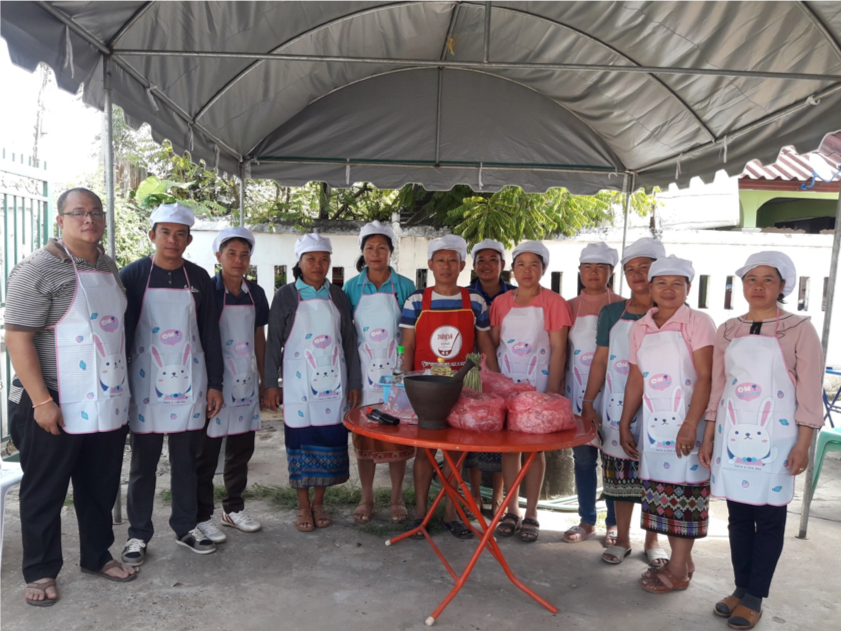
Scaling out pig production in Dong Kha to the district
– January 2019 –
By Lampheuy Kaensombath and Khamla Sengphaxaiyalath –
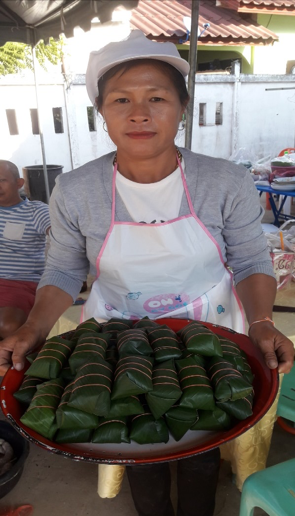
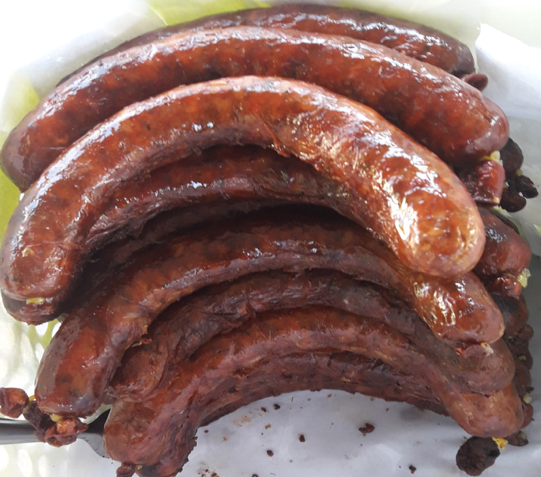
“We put in our action plan to make sausages and here there are,” says group marketing committee member Mrs Dao
Eight group members and two DAFO (government) staff spent a week in November 2018 in Vientiane learning to make sausages. Making sausages is not very difficult. Making good sausages is a little more difficult, but finding someone willing to teach the group was the most difficult task. “If someone has a good recipe, they want to keep it secret,” says group member
“I feel our group has more power than before. We decide what we want to do and make a plan and then we do it.”
Mr Satian Khamchaleun
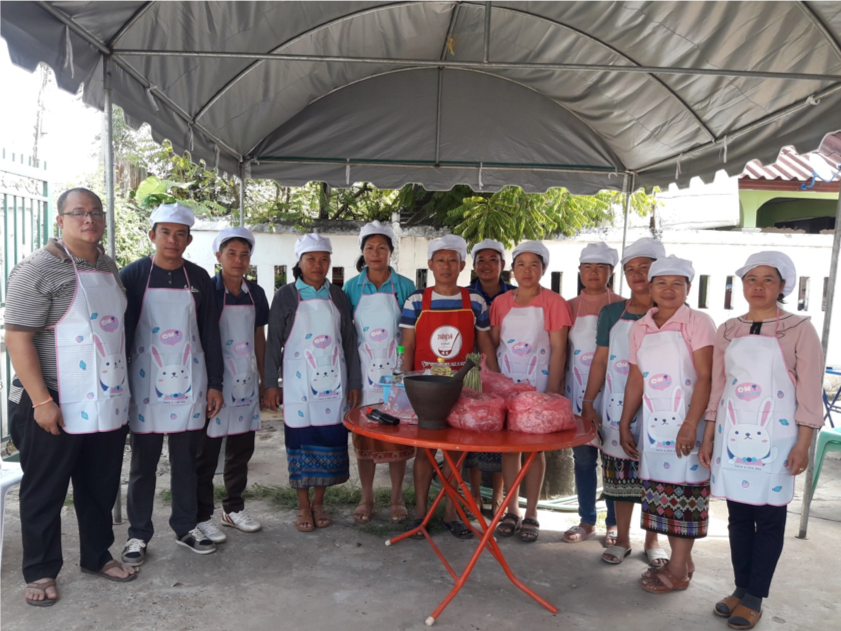
Training and value chain assessment
“It’s working!” says Khamla. “DAFO staff are now starting to take over the training for some of the ideas CDAIS has introduced.” That process took nearly a year. In March 2018,
CDAIS provided US$3000 to fund DAFO capacity development for scaling out pig production to five villages in the district in June 2018 as part of the extension management system and Xanakham DAFO action plan, in Buachaleun, Napieng, Nasack, Nonsavanh, Nakang. “We don’t give funding to groups or government departments for equipment or materials or grants,” says Patrick D’Aquino, Agrinatura Country Focal Point for CDAIS, “However, we do have a small fund for capacity development, in this case to kickstart the scaling out of an innovation as DAFO has no budget yet for these kind of activities.”
A second training workshop in November brought together three DAFO staff with representatives from the selected villages for training on value chain assessment in three districts of Xayabouli Province. Two villages had decided that rather than produce pigs they wanted to be traders and buy and sell them.
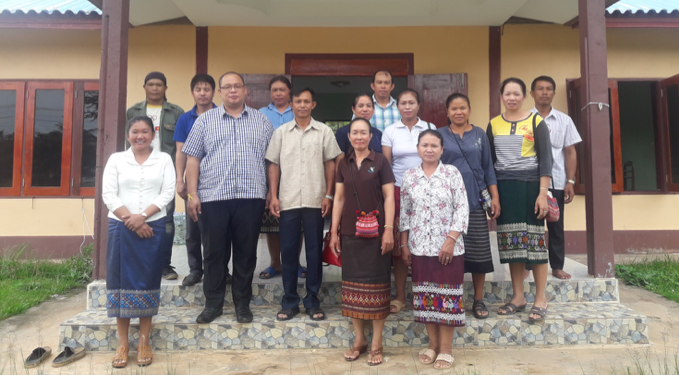
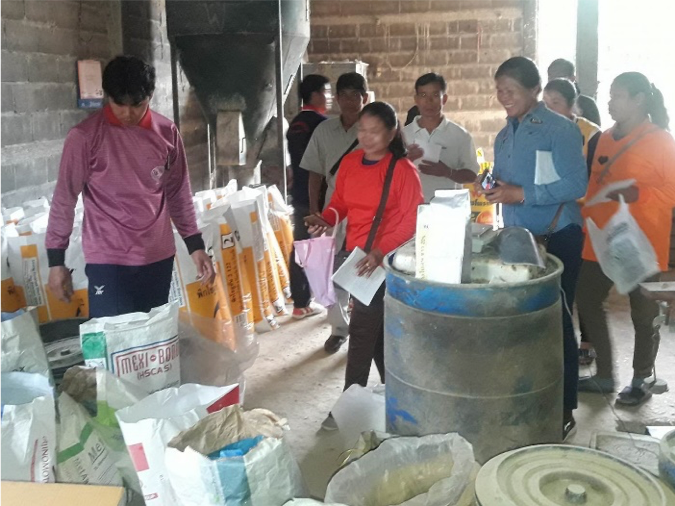
Early in December, a team of DAFO staff and group members from Dongkha village went on a study tour to Xayabouli Province to apply their new skills. People from Xayabouli have been coming to buy pigs and piglets from the Dong Kha group for some time now and they decided it was time to learn more about the market potential. As a result of this, the group found that there is a large potential market for live pigs in Xayabouli, since Pieng District imports all its pigs, or some 400-500 head per month. Xayabouli District pig farms can only supply 70%, with 30% from a farm in Vientiane. The government has recently banned imports of live pigs and pork from Thailand which will create more demand from local suppliers. The tour was also an opportunity to meet new partners and exchange information and knowledge on how to conduct trade between the two provinces. In addition, DAFO staff had a chance to learn about support services for management of trading and slaughtering and regulations in other districts.
Making feed
One of the challenges of commercial livestock production is finding the optimal diet for your animals. “We can buy commercial feeds but they are expensive,” says Mr Satian Khamchaleun, “and it will be much better if we can make our own feed.”
On their study tour to Thailand in January 2018, the group learned how to make pig feed from the Livestock Research Centre and the owners of Yong Yut Farm in Loei Province. Many of the main ingredients are easily available in Xanakham District, and after being to the farm and seen for themselves, group members are confident this recipe is good for animal health and optimal growth. “Making our own feed will cut down a lot on our cost of production,” says Mrs Pheng, one of the two group management committee members in charge of accounting.
“One of the things we need to do is raise awareness about antimicrobial drug resistance (AMR) and now that the group is making their own feed would be a good time,” says Khamla. The threat to animal and human health from AMR is widely recognised at the global level, which means there are available resources CDAIS can use, including outputs from CIRAD and FAO initiatives on AMR.
The road ahead
The original group started with 12 registered members, expanding to include 20 more families in Dong Kha in the past year. Working with DAFO, the group has begun to scale out to four neighbouring villages to involve 25 new members, 15 from Buachaleun, six from Napieng and four from Nasack.

Biogas production is another item in the groups ambitious action plan. What people are doing now is directing all the manure from their pens to a holding pond and then spreading it on their fields during the dry season. This method is far superior to simply pumping it into any available water supply but there is some groundwater pollution and pig manure has a strong, unpleasant smell.
Technologies for producing biogas are simple and while the cost of materials is not high, it still requires investment. The methane gas produced can be compressed in the same tanks people use for their LPG cooking gas, but at a fraction of the cost, and most of the cost will be recovered from those savings. Biogas is not high on the group’s list of priorities however, and they need to gather more information, but there are a number of other biogas project in Laos they can contact for help. “I have no doubt that if they want to do it, they will,” says Khamla. “The group now has a history of success achieving their goals and that gives them great confidence.”

Producing biogas from pig manure is not difficult, with the cost quickly recovered through savings on LPG cooking gas. 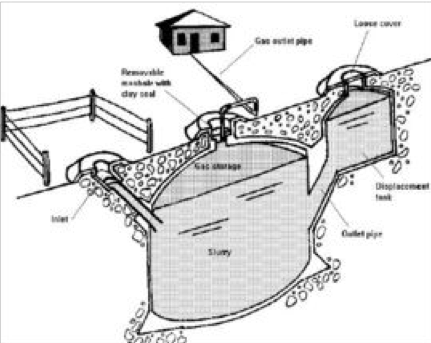
“I feel now we are a strong production group” says Mr Satian Khamchaleun. “Our growth in capacity comes from our own actions through the support from CDAIS and local authorities. Our group is now good at sharing information and working together to achieve the goals we set in our action plan.” Mrs Dao add, “We are more smoothly connecting to local stakeholders compared to the past.”
Khamla hopes to see them complete some of their action points before that, in particular, undertaking training for meat processing in Thailand currently under discussion, a study tour to visit a sausage factory in Luang Prabang Province where they make traditional Lao sausage, and another study tour to Thailand to learn how to make biogas.
“It is our goal to raise enough piglets of our own for all group members, to make more of our own feed, add more processed meat products to our value chain, and to have contracts with local and provincial traders,” saysgroup leader Mr Satian Khamchaleun.
This is an update of an earlier Story of Change, ‘Pig farmers building bridges to success’ published on www.cdais.netin July 2018.
Prepared by
Lampheuy Kaensombath is CDAIS lead national innovation facilitator (lampheuyk@gmail.com, +856 02 0 2829 9751), Khamla Sengphaxaiyalath is the CDAIS national innovation facilitator for the pig production niche (khamla.s772@gmail.com, +856 020 2333 6020).
Pig rearing one of five innovation niche partnerships in Lao PDR being developed as part of the


The views expressed herein can in no way be taken to reflect the official opinion of the European Union. © 2019
